
Saint Lawrence or Laurence was one of the seven deacons of the city of Rome under Pope Sixtus II who were martyred in the persecution of the Christians that the Roman Emperor Valerian ordered in 258.

Denis of France was a 3rd-century Christian martyr and saint. According to his hagiographies, he was bishop of Paris in the third century and, together with his companions Rusticus and Eleutherius, was martyred for his faith by decapitation. Some accounts placed this during Domitian's persecution and incorrectly identified St Denis of Paris with the Areopagite who was converted by Paul the Apostle and who served as the first bishop of Athens. Assuming Denis's historicity, it is now considered more likely that he suffered under the persecution of the emperor Decius shortly after AD 250.
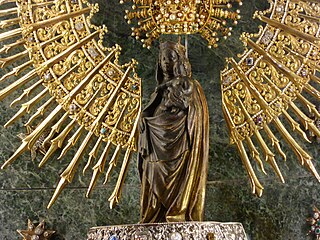
Our Lady of the Pillar is the name given to the Blessed Virgin Mary in the context of the traditional belief that Mary, while living in Jerusalem, supernaturally appeared to the Apostle James the Greater in AD 40 while he was preaching in what is now Spain. Those who adhere to this belief consider this appearance to be the only recorded instance of Mary exhibiting the mystical phenomenon of bilocation. Among Catholics, it is also considered the first Marian apparition, and unique because it happened while Mary was still living on Earth.
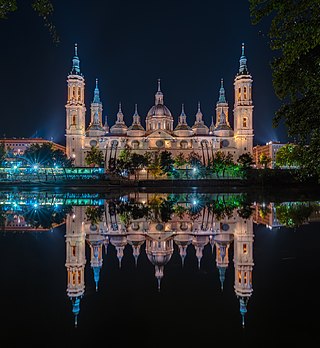
The Cathedral-Basilica of Our Lady of the Pillar is a Catholic church in the city of Zaragoza, Aragon (Spain). The basilica's titular is the Blessed Virgin Mary under the title of Our Lady of the Pillar, praised as "Mother of the Hispanic Peoples" by Pope John Paul II. It is reputed to be the first church dedicated to Mary in history.

The Basilica of Saint Praxedes, commonly known in Italian as Santa Prassede, is an early medieval titular church and minor basilica located near the papal basilica of Saint Mary Major, on Via di Santa Prassede, rione Monti in Rome, Italy. The current Cardinal Priest of Titulus Sancta Praxedis is Paul Poupard.

The Church of Saint Susanna at the Baths of Diocletian is a Roman Catholic parish church located on the Quirinal Hill in Rome, Italy. There has been a titular church associated to its site as far back as AD 280. The current church was rebuilt from 1585 to 1603 for a monastery of Cistercian nuns founded on the site in 1587, which still exists there.

Santi Quattro Coronati is an ancient basilica in Rome, Italy. The church dates back to the fourth or fifth century, and is devoted to four anonymous saints and martyrs. The complex of the basilica with its two courtyards, the fortified Cardinal Palace with the Saint Silvester Chapel, and the monastery with its cosmatesque cloister is built in a silent and green part of Rome, between the Colosseum and San Giovanni in Laterano, in an out-of-time setting.

The Abbey of Saint-Victor is a former abbey that was founded during the late Roman period in Marseille in the south of France, named after the local soldier saint and martyr, Victor of Marseilles.
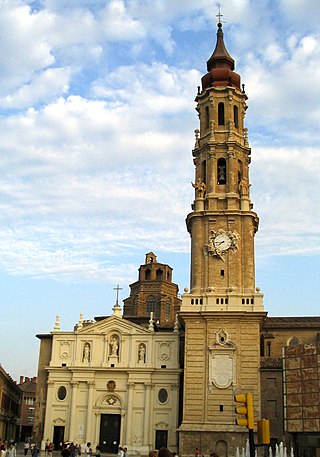
The Archdiocese of Saragossa is a Latin diocese of the Catholic Church located in north-eastern Spain, in the province of Zaragoza, part of the autonomous community of Aragón. The archdiocese heads the ecclesiastical province of Saragossa, having metropolitan authority over the suffragan dioceses of Barbastro-Monzón, Huesca, Tarazona, and Teruel and Albarracín.
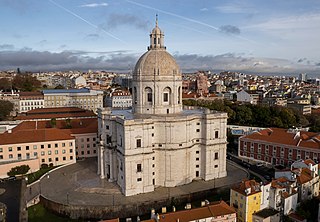
The Church of Santa Engrácia is a 17th-century monument in Lisbon, Portugal. Originally a church, it was converted into the National Pantheon, in which important Portuguese personalities are buried. It is located in the Alfama neighbourhood, close to another important Lisbon monument, the Monastery of São Vicente de Fora.

Tre Fontane Abbey, or the Abbey of Saints Vincent and Anastasius, is a Roman Catholic abbey in Rome, held by monks of the Cistercian Order of the Strict Observance, better known as Trappists. It is known for raising the lambs whose wool is used to weave the pallia of new metropolitan archbishops. The pope blesses the lambs on the feast of Saint Agnes on January 21. The wool is prepared, and he gives the pallia to the new archbishops on the Solemnity of Saints Peter and Paul, the Holy Apostles.

Saint Hermes, born in Greece, died in Rome as a martyr in 120, is venerated as a saint by the Catholic Church and the Eastern Orthodox Church. His name appears in the Martyrologium Hieronymianum as well as entries in the Depositio Martyrum (354). There was a large basilica over his tomb that was built around 600 by Pope Pelagius I and restored by Pope Adrian I. A catacomb in the Salarian Way bears his name.
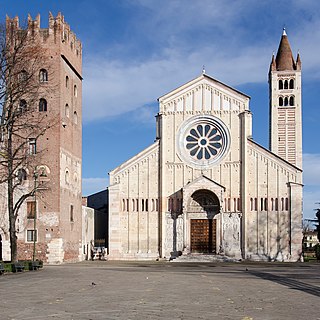
The Basilica di San Zeno is a minor basilica of Verona, northern Italy constructed between 967 and 1398 AD. Its fame rests partly on its Romanesque architecture and partly upon the tradition that its crypt was the place of the marriage of Shakespeare's Romeo and Juliet. It stands adjacent to a Benedictine abbey, both dedicated to St Zeno of Verona.

Engratia is venerated as a virgin martyr and saint. Tradition states that she was martyred with eighteen companions in 303 AD.

The title Virgin is an honorific bestowed on female saints and blesseds, primarily used in the Eastern Orthodox Church and the Catholic Church.

Fridianus, was an Irish prince and hermit, fl. 6th century. Tradition names him as a son of King Ultach of Ulster. He later migrated to Italy, where he was appointed as Bishop of Lucca. The Basilica of San Frediano in the city is dedicated to him, as are churches in Florence.
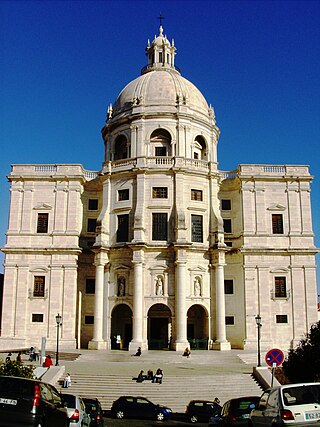
Santa Engrácia is a former parish (freguesia) in the municipality of Lisbon, Portugal. At the administrative reorganization of Lisbon on 8 December 2012 it became part of the parish São Vicente. It has a total area of 0.57 km2 and total population of 5,860 inhabitants (2001); density: 10,335.1 inhabitants/km2.

The Abbey of Santa Engracia was a monastery in Zaragoza, Aragon, Spain, established to house the relics of Saint Engratia and the many martyrs of Saragossa. The date of 392 was traditionally claimed as a foundation date, which was linked with the travels of Saint Paulinus. The church was believed to have been sited on the spot of the martyrdom of Engratia.

The Abbey of Santa Giustina is a 10th-century Benedictine abbey complex located in front of the Prato della Valle in central Padua, region of Veneto, Italy. Adjacent to the former monastery is the basilica church of Santa Giustina, initially built in the 6th century, but whose present form derives from a 17th-century reconstruction.

Palestrina Cathedral is a Roman Catholic cathedral located in Palestrina, in the region of Lazio, Italy. It is the episcopal seat of the Suburbicarian Diocese of Palestrina, and dedicated to Saint Agapitus.




















